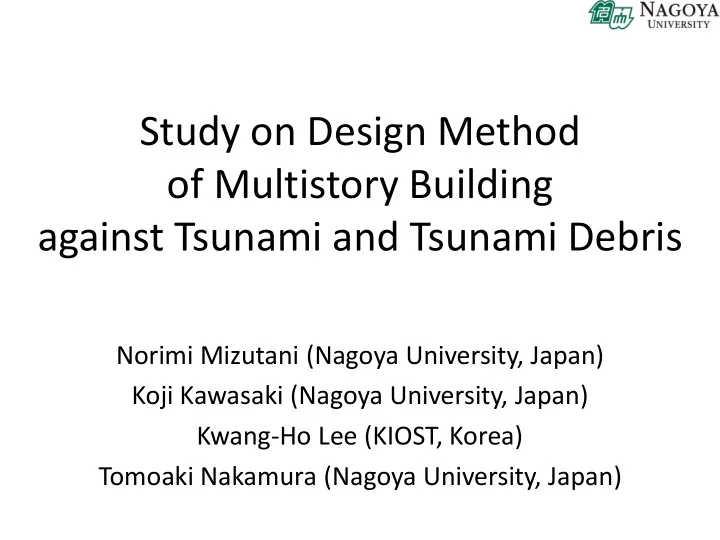

Study on Design Method of Multistory Building against Tsunami and Tsunami Debris Norimi Mizutani (Nagoya University, Japan) Koji Kawasaki (Nagoya University, Japan) Kwang-Ho Lee (KIOST, Korea) Tomoaki Nakamura (Nagoya University, Japan)
Background and objectives • Tsunami-resistant RC multistory buildings located along coasts – Tsunami evacuation buildings in case of tsunami attack – Usually served as utility spaces on lower floors, and residential spaces on upper floors However, RC buildings were destroyed in the 2011 Tohoku earthquake tsunami. It is necessary to revise the design standard of tsunami-resistant buildings Taken during the joint field survey in Onagawa, Japan Tsunami-induced wave force and the impact force of tsunami- borne debris were investigated to determine the requirements of the structural design of tsunami-resistant RC buildings 2
Contents of this project • Characteristics of the 2011 Tohoku earthquake tsunami – Field survey as a team of “The 2011 Tohoku Earthquake Tsunami Joint Survey Froup” in April 2011 – Joint field survey with the US team in June 2011 • Incident tsunami – Simulation of tsunami propagation and inundation • Wave force acting on buildings – Tsunami-induced wave force acting on buildings – Response of a concrete column subject to tsunamis • Impact force acting on buildings – Behavior of tsunami-borne shipping containers (debris) • Stability of the foundation of buildings – Tsunami-induced local scouring on the foundation 3
Tsunami simulation • Propagation of tsunamis due to expected Tokai, Tonankai, and Nankai earthquakes with Mw 9.0 4
Tsunami simulation • Inundation around the head of the Ise bay in the absence of riverine and coastal structures Inundation area is significantly affected by the structures Useful information for making disaster prevention/mitigation plans 5
Tsunami force acting on buildings • RC buildings and RC walls were destroyed in the 2011 Tohoku earthquake tsunami Onagawa, Japan Sendai, Japan • Tsunami force acting on various types of building was investigated using hydraulic experiments and numerical simulation Building A Building B – Hydraulic experiments in Nagoya Univ. – 3-D numerical model based on the immersed-boundary (IB) model 6 Building C
Tsunami force acting on buildings • Wave pressure distribution on the buildings Impermeable With windows Piloti-type Wave pressure can be reduced for piloti-type buildings 7
Tsunami-borne shipping container • Tsunami-borne containers can collide with and destroy buildings • The drift behavior of a container was investigated using hydraulic experiments and numerical simulation Wall – Hydraulic experiments in Nagoya Univ. – 3-D coupled fluid-structure interaction numerical model for simulating tsunami- container interaction Container • Results for a container falling out to the sea Model Experimental result Numerical result 8
Tsunami-borne shipping container • Countermeasures for preventing a container from flowing out to the sea Type 1. High wall installed at the Type 2. Wall installed at the seaward edge of the apron landward side of the container If the wall high enough, The wall can prevent the it can be obstacle for the container from flowing flowing container out to the sea effectively 9
Tsunami-induced local scouring • Local scouring can reduce the stability of buildings 2010 Chilean earthquake 2011 Tohoku earthquake tsunami tsunami Dichato, Chile Kesen-numa, Japan • The mechanism of tsunami-induced Column local scouring was investigated using hydraulic experiments and numerical simulation – Hydraulic experiments in Nagoya Univ. – 3-D coupled fluid-sediment interaction numerical model for tsunami-scour Sand Seawall interaction 10
Tsunami-induced local scouring Experimental result Final scour depth Tsunami Scour hole Numerical result Process of scouring Final scour depth Tsunami Capable of evaluating the evolution of local scouring 11
Summary • Tsunami-induced wave force and the impact force of tsunami- borne debris were investigated to determine the requirements of the structural design of tsunami-resistant multistory buildings – Useful simulation results of tsunami propagation and inundation were obtained to make disaster prevention/mitigation plans – Tsunami-induced wave force can be reduced for piloti-type buildings compared with impermeable buildings without windows – Countermeasure walls would be effective to prevent tsunami-borne shipping containers from flowing out to the sea – The evolution of tsunami-induced local scouring on the foundation of buildings can be simulated and evaluated using the developed model • Collaboration of the US team and the Japanese team was essential to complete this project (sharing project results, conducting field survey, etc.) Thank you very much for your attention 12
Recommend
More recommend